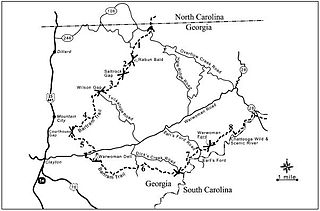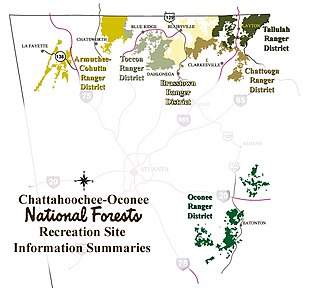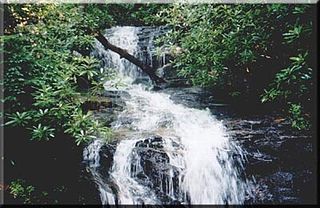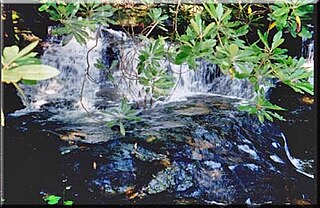Roscoe Conklin Nicholson (January 22, 1887 – October 22, 1959) [1] was a surveyor and early advocate of conservation, who played an important role in preserving forest land in the U.S. state of Georgia in the early 20th century.

Surveying or land surveying is the technique, profession, and science of determining the terrestrial or three-dimensional positions of points and the distances and angles between them. A land surveying professional is called a land surveyor. These points are usually on the surface of the Earth, and they are often used to establish maps and boundaries for ownership, locations, such as building corners or the surface location of subsurface features, or other purposes required by government or civil law, such as property sales.

The United States of America (USA), commonly known as the United States or America, is a country composed of 50 states, a federal district, five major self-governing territories, and various possessions. At 3.8 million square miles, the United States is the world's third or fourth largest country by total area and is slightly smaller than the entire continent of Europe's 3.9 million square miles. With a population of over 327 million people, the U.S. is the third most populous country. The capital is Washington, D.C., and the largest city by population is New York City. Forty-eight states and the capital's federal district are contiguous in North America between Canada and Mexico. The State of Alaska is in the northwest corner of North America, bordered by Canada to the east and across the Bering Strait from Russia to the west. The State of Hawaii is an archipelago in the mid-Pacific Ocean. The U.S. territories are scattered about the Pacific Ocean and the Caribbean Sea, stretching across nine official time zones. The extremely diverse geography, climate, and wildlife of the United States make it one of the world's 18 megadiverse countries.

Georgia is a state in the Southeastern United States. It began as a British colony in 1733, the last and southernmost of the original Thirteen Colonies to be established. Named after King George II of Great Britain, the Province of Georgia covered the area from South Carolina south to Spanish Florida and west to French Louisiana at the Mississippi River. Georgia was the fourth state to ratify the United States Constitution, on January 2, 1788. In 1802–1804, western Georgia was split to the Mississippi Territory, which later split to form Alabama with part of former West Florida in 1819. Georgia declared its secession from the Union on January 19, 1861, and was one of the original seven Confederate states. It was the last state to be restored to the Union, on July 15, 1870. Georgia is the 24th largest and the 8th most populous of the 50 United States. From 2007 to 2008, 14 of Georgia's counties ranked among the nation's 100 fastest-growing, second only to Texas. Georgia is known as the Peach State and the Empire State of the South. Atlanta, the state's capital and most populous city, has been named a global city. Atlanta's metropolitan area contains about 55% of the population of the entire state.
Born and raised in Pine Mountain, an unincorporated community at the eastern edge of Rabun County, Georgia he was the first forest ranger in Georgia. [2] Before becoming Georgia's first forest ranger in 1912, he worked as a surveyor for the federal government.
Pine Mountain is an unincorporated community located in eastern Rabun County, Georgia, United States, at an elevation of 1661 feet. It is one of only two Georgia communities located north of South Carolina, due to a quirk of geography: the Chattooga River is the primary tributary of the Savannah River and Tugalo River specified in the 1787 Treaty of Beaufort, but runs perpendicular to them.
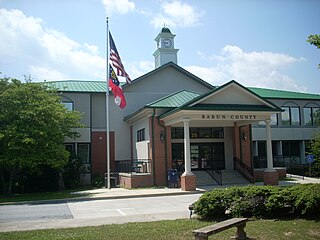
Rabun County is the northeasternmost county in the U.S. state of Georgia. As of the 2010 census, the population was 16,276. The county seat is Clayton.
Nicholson advised the United States Forest Service in its initial and subsequent land purchases in what is now the Chattooga River Ranger District of the Chattahoochee National Forest. He and Arthur Woody are considered to be the two most important early figures in the history of the Chattahoochee National Forest. In addition to being instrumental in the early land purchases, Ranger "Nick", as he was called, worked to prevent forest fires by purchasing bloodhounds to track arsonists and building the first fire tower in the area on Rabun Bald (second-highest peak in Georgia). He also played an important role in establishing telecommunications in the region, being responsible for having telephone lines run from Clayton, Georgia to Pine Mountain.

The United States Forest Service (USFS) is an agency of the U.S. Department of Agriculture that administers the nation's 154 national forests and 20 national grasslands, which encompass 193 million acres (780,000 km2). Major divisions of the agency include the National Forest System, State and Private Forestry, Business Operations, and the Research and Development branch. Managing approximately 25% of federal lands, it is the only major national land agency that is outside the U.S. Department of the Interior.
Arthur Woody was born in Suches, Georgia. He was an American conservationist and humanitarian who saw his father kill the last deer in the North Georgia mountains in 1895, and is credited with bringing deer back to the North Georgia mountains. As a forest ranger for the United States Forest Service, he served in Georgia from 1912 to 1945 and was involved in the acquisition of land in what became the Chattahoochee National Forest. He also is known for putting rainbow and brown trout in streams, restoring native brook trout, restoring turkey and black bear populations and was the driving force behind Blue Ridge Wildlife Management Area, the first of its kind in Georgia and the nation. He built lakes, fire towers, brought roads to the area, built Woody Gap School in Suches, Georgia (1940), was instrumental in building the Appalachian Trail through Georgia, and did much to help his mountain people during the Great Depression.

Rabun Bald, with an elevation of 4,696 feet (1,431 m), is the second-highest peak in the U.S. state of Georgia; only Brasstown Bald 4,784 feet (1,458 m) is higher. It is immediately southeast of Sky Valley, Georgia, and is the tallest mountain in the county. An observation tower on the summit provides hikers with views that, on clear days, extend for more than 100 miles (160 km). The hike to the top of Rabun Bald is 5.8 miles (9.3 km) round trip via the Rabun Bald Trail. The Rabun Bald Trail connects with the Bartram Trail system, which passes over the top as it winds through northeast Georgia for 37 miles (60 km).
Ranger "Nick" retired in 1952. In 1960, the Coleman River Scenic Area near Clayton, Georgia was dedicated to Ranger "Nick" following his 40 years of public service in honor of his promotion of conservation ideals and other work. [3]
The Coleman River Scenic Area is located in Rabun County, Georgia in the Chattooga River District of the Chattahoochee National Forest. It is located at the point of confluence of Coleman River with the Tallulah River. The scenic area consists of 330 acres (1.3 km2) encompassing lower Coleman River and was dedicated in 1960 to "Ranger Nick" Nicholson following his 40 years of public service. At the point of confluence of the two rivers, the elevation is approximately 2,200 feet (670 m).

Clayton is a city in Rabun County, Georgia, United States. The population was 2,047 at the 2010 census. The city is the county seat of Rabun County and is located in the Blue Ridge Mountains.




